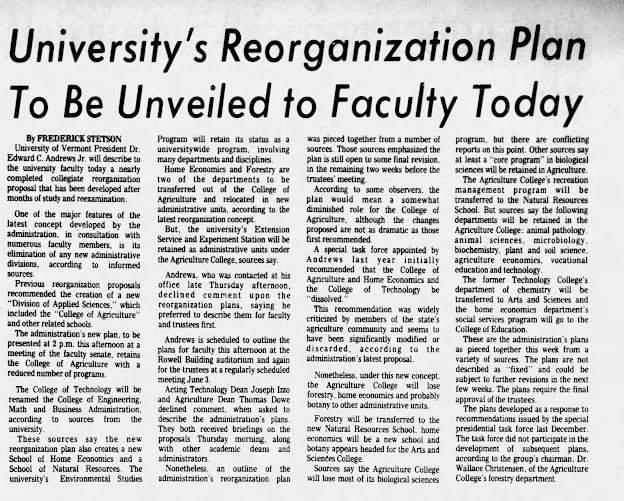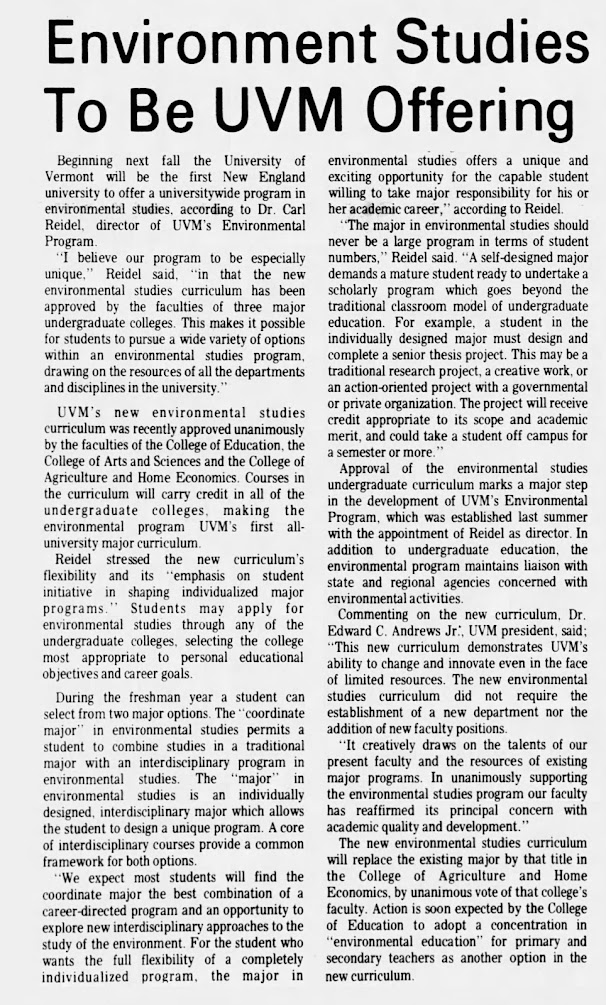BACG History Post #10
1973 was a watershed year at the University of Vermont. In February, the university's trustees faced a situation of deficit financing accompanied by reduced federal and state support.
The Trustees approved increases to room and board, fees, and nonresident tuition. Tuition increases for Vermont students remained on the table.In May, 1973, UVM’s president Edward Andrews, Jr., proposed a sweeping reorganization of colleges and departments.

UVM's College of Agriculture, the flagship of the land grant university, was affected by the reorganization. Forestry and Recreation Management programs were transferred from the Ag College to the School of Natural Resources. Home Economics was transferred from the Ag College to a school of its own.
Tommy Thompson began outreach work with Gardens for All in January, 1973. He arranged meetings with Thomas Dow, dean of the College of Agriculture; Robert Davidson, director of the UVM Extension Service; and Sam Wiggins, chair of the Plant and Soil Science Department.The climate at the College of Agriculture was not particularly favorable to new programs, especially those not directly related to farming and agri-business. Thompson’s idea of establishing community gardens on UVM land was rejected by Dow, Davidson, and Wiggins.
Tommy Thompson was patient. He reached out to UVM's newly created Environmental Studies Program, the first of its kind offered at a New England University. The program was a favorite of President Andrews, who wanted the Environment Studies curriculum integrated into all disciplines.
Carl Reidel was the program’s director. Reidel was consumed with getting the curriculum approved through the various schools and colleges on campus. He handed Thompson's inquiry off to Tom Hudspeth, assistant director of the Environmental Studies Program. Reidel wanted Hudspeth to take the lead on outreach and extension projects.
Hudspeth was hired by UVM in August 1972, after earning his Masters degree at the University of Michigan. As a graduate student, he had been part of a multicultural community garden in Ann Arbor. Many of the ethnic vegetable varieties raised in the gardens were new to Hudspeth, who grew up in Houston.
The Environmental Studies Program was open to action-oriented projects that went beyond the traditional model of undergraduate education. Projects could include working with community and nonprofit organizations.
At a spring reception, Hudspeth talked with President Andrews about Thompson’s idea for a community garden program. Andrews expressed interest. He gave Hudspeth his card and asked if there was anything he could do to make the program a success.
“I called the number on the card,” said Hudspeth. Expecting to reach a secretary, he was amazed when President Andrews answered the call. “Come to my office,” he said to Hudspeth.Hudspeth and Andrews met with Larry Snyder, UVM’s head of development, who oversaw buildings and grounds. "We poured over maps to figure out good sites for gardens," said Hudspeth.
UVM maintained several acres of land in an apple orchard parallel to East Avenue. The trees were planted in wide rows with ample space in between the trees. The Orchard site was approved as the first community garden on UVM land.
A second community garden site was added behind the UVM Admissions building on South Prospect Street. UVM owned land at the East Avenue jughandle. The jughandle site was plowed during the fall of 1973 to support community gardens opening the following spring.
Hudspeth community gardened first at the Orchard site, then later at the Admissions site which he helped to coordinate in 1973 and 1974. He remembers Tommy Thompson being resourceful in arranging for truckloads of fresh compost to be delivered to the community garden sites. The Gardens for All newsletter below encouraged leaf composting at the UVM sites.

